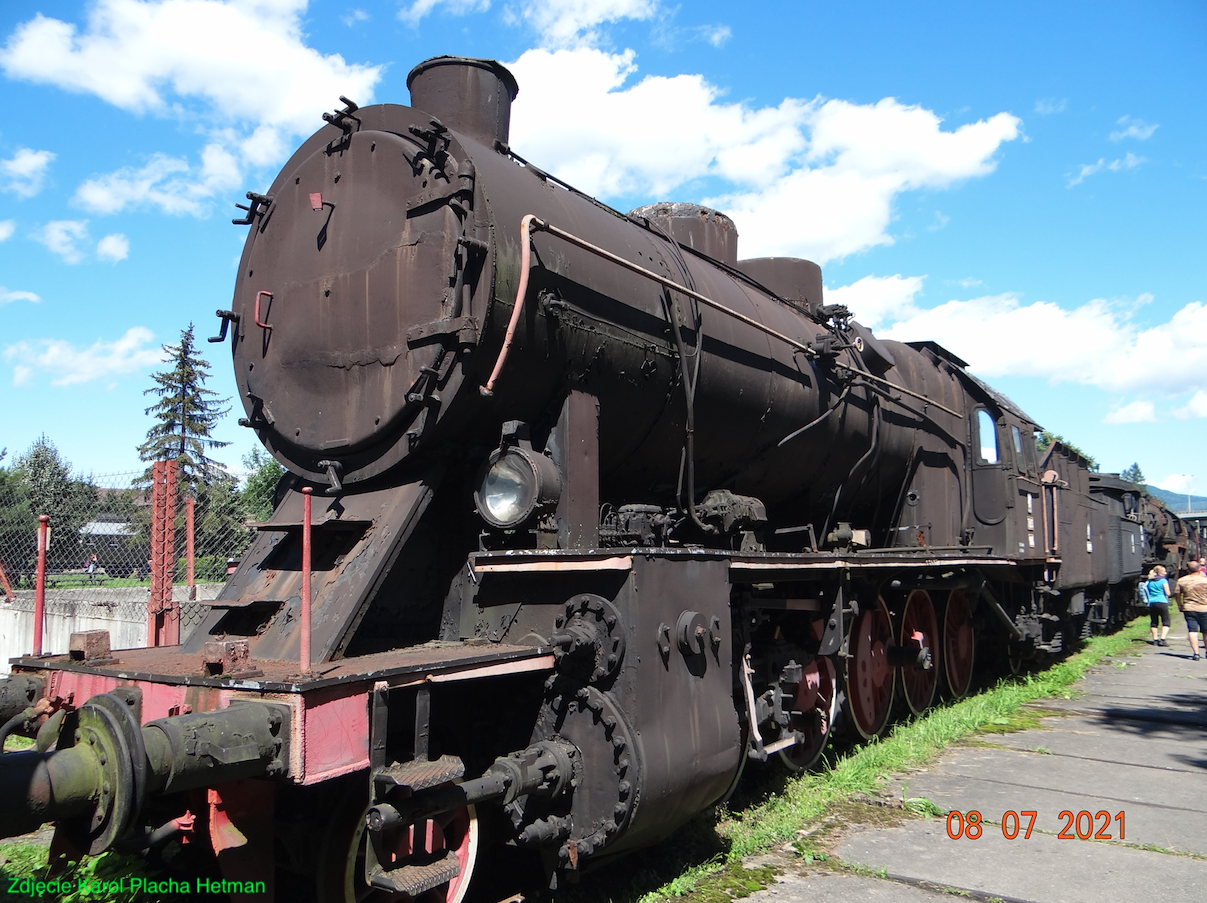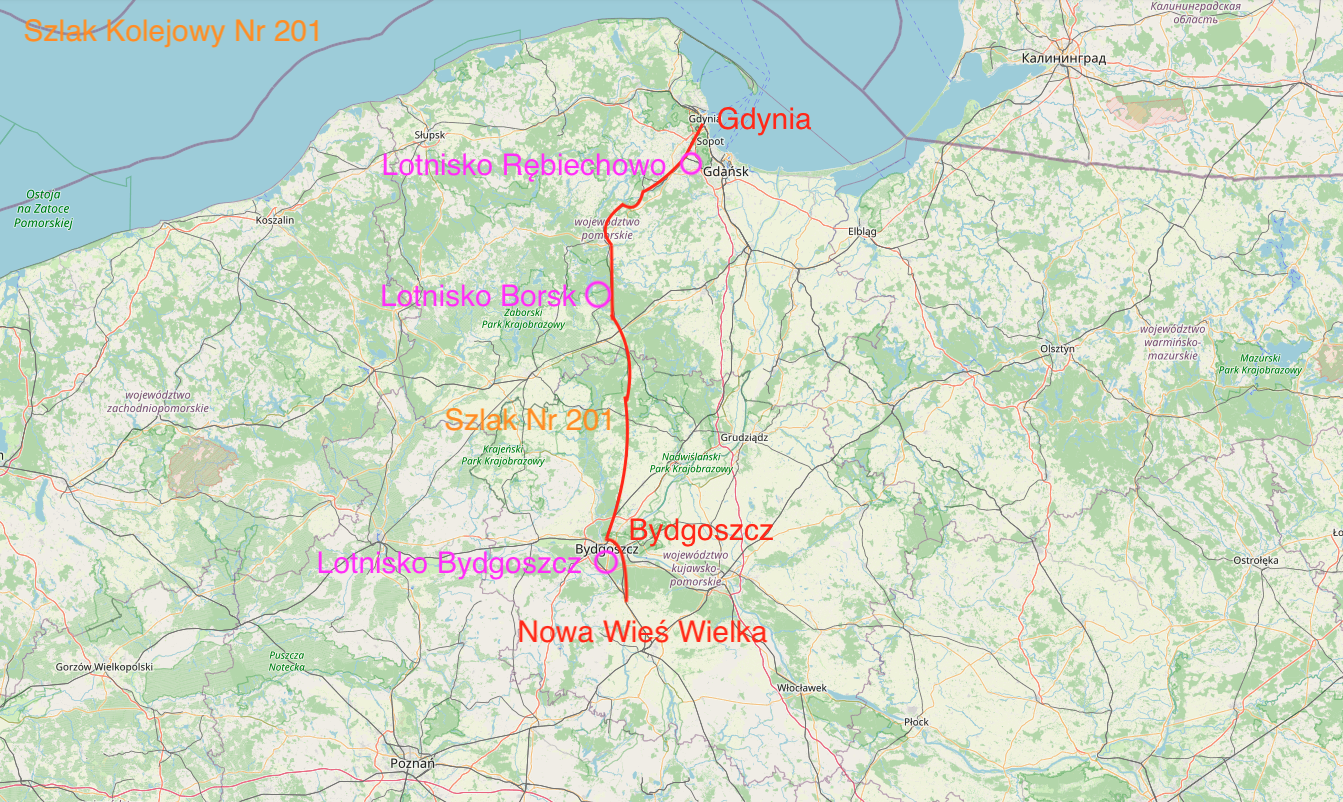Gdańsk 2021-01-25
Gdańsk Rębiechowo - railway.

Photo description: The Ty23 series steam locomotive was a Polish heavy steam locomotive, which was developed by Polish engineers and produced in the period 1923 - 1934. Ty23 means a freight locomotive with the "y" axle arrangement, which was approved in 1923. The axis system is 1'E, i.e. 1-5-0 (oOOOOO), and the Polish designation is a small letter "y". Locomotives of this type worked during the Second Polish Republic on the No. 201 railway route, transporting hard coal from Polish Silesia to the seaport in Gdynia.

By train to the Gdańsk-Rębiechowo airport.
The 90s of the 20th century and the first decade of the 21st century are the period of liquidation of railways in Poland. However, the experiences of other countries have shown that rail is a good means of transport. In 2010, the first plans to rebuild the railway network in the Tri-City area were made. The project was called the Metropolitan Railway. The Ministry of Regional Development entered the investment on the list of projects financed under the Infrastructure and Environment Operational Program. The investment was divided into several stages, as its cost was estimated at PLN 650 million. Half of this amount came from EU (European Union) subsidies, and the rest from the voivodeship authorities, Gdańsk, Gdynia and PKP. The Metropolitan Railway was a big step in the development of the Tri-City Agglomeration.
The new line starts at the SKM Gdańsk Zaspa stop. On the old railway embankment, on which once ran the line Gdańsk - Gdańsk Kokoszki, and reaches the vicinity of the terminal at the airport. Several stops were built on this section: Gdańsk Strzyża, Gdańsk Niedźwiednik, Gdańsk Brętowo, Gdańsk Jasień, Gdańsk Kiełpienik, Gdańsk Maternia, Gdańsk Airport and Gdańsk Rębiechowo.
The railway line is double-track, non-quantified. There are plans to electrify the line by 2025. Many sections of the track run along the former railway embankment. In the first years of operation, there were problems with landslides from the embankments, after heavy rains. At the Rebiechowo Airport itself, a decision was made to build a flyover, the total length of which is 900 m. The flyover allowed to maintain the layout of car roads and parking lots at the airport.
The Gdańsk Port Lotniczy stop was not called Gdańsk Airport, because such a stop was at the Wrzeszcz Airport. The stop has two platforms, which are connected to Terminal 2 by a built-up, glazed footbridge.
The metropolitan railway line continues. It runs in a north-west direction, then splits left and right to the Gdynia-Żukowo railway line (north-south direction). It is exactly the railway line No. 201 Gdynia Port - Nowa Wieś Wielka. The railway line No. 201 is part of the Magistrala Węglowa, one of the main investments in the Second Polish Republic and was a line of national importance. Due to the German attack on Poland, the line lost its importance and was a local line. Currently (2020), the metropolitan line has opened the Tri-City in Kartuzy and Kościerzyna. The railway line facilitates the access of passengers to the airport and Gdańsk. About 46 million euros were spent on the modernization of the Koscierzyna route in the Regional Operational Program, and the modernization was completed in 2015. The journey from Kartuzy to the airport takes 30 minutes.
The metropolitan railway line was officially opened on September 1, 2015. During the day the railway carries 1000-2000 passengers. The line is operated by SKM and Polregio trains. These are diesel sets, two-, three- or four-car. Tickets can be purchased from ticket machines at railway stops or from the train manager (conductor). The carrier's tariff SKM and Polregio apply.
The history of railways in the vicinity of the airports: Rębiechowo (Gdańsk), Borsk (Former military airport), Szwedowo (Bydgoszcz).
The railway line No. 201, of national importance for Poland, runs from the eastern side of the Rębiechowo airport. In 1918, Poland regained its independence, and the reconstruction and development of the destroyed country began. One of the priorities was the development of railways, which are the main pillar of transport. In 1920, the Polish government established the main transport routes. One of the main routes was the one leading from Silesia to the coast. As cooperation with Germany was not going well, it was decided to route the planned routes in such a way as to avoid German territories and the area of the Free City of Gdańsk, whose authorities manifested open hostility towards Poland. Germany often referred to Poland as a "seasonal state". That is why, among other things, Poland has built the "Port of Gdynia".
Railway line No. 201 - History.
Detailed plans of the railway routes were created in the years 1926-1928. Among them, the railway line No. 201, generally referred to as Bydgoszcz-Gdynia. The new main line was to run as close to the straight course as possible. Due to modest funds, the route was to be single-track, with the prospect of building a second track. This forced the construction of passages at equal intervals, regardless of the existing localities. This is how the stations among forests were created. The line has become one of the most picturesque in Poland. It is located in the provinces of Kujawsko-Pomorskie and Pomorskie. Geographically, it runs through the Pomeranian Lakeland, the Kashubian Lakeland and the Gdańsk Coast.
Already in 1925, a government ordinance was ready under which owners of real estate needed to build a railway could be expropriated. The railroad itself was built by a state-owned company, but bridges and other infrastructure were built by private companies after winning tenders. Trail No. 201 was put into use in stages. The first stage, around Bydgoszcz, was commissioned on May 15, 1928. It runs some distance from the Szwedowo airport. The second stage was the Czersk-Bąk-Kościerzyna section, which shortened the Tczew-Kościerzyna route, without the need to drive to Chojnice. The Czersk-Bąk section runs a strange route, because the Poles used the Karsin-Bąk railway embankment, the Chojnice-Gdańsk line not built by the Germans, which would be an extension of the railway line No. 210 (Berlin-Królewiec).
In 1930, the French joined the program to build the line No. 201 and a company was established: the French-Polish Railway Society. The establishment of the company accelerated the construction process.
On November 9, 1930, trail No. 201 was already passable along its entire length. The main line No. 201 is transformed from the Gdynia station into the Gdynia Port railway siding. Until 1933, station buildings, water towers and carburizing equipment were built along the route No. 201. Due to the residents' demands, additional stations were built along the trail, for example Babi Dół and Żukowo Wschodnie.
In 30 years, line No. 201 served mainly freight trains and express trains from Gdynia to Warsaw, Kraków, Lviv and Silesia. Most of the regular passenger trains went from Tczew to Gdańsk.
During the Second World War, route No. 201 was significantly damaged. The occupier used mainly the Tczew-Pruszcz Gdański-Gdańsk route.
After the Second World War, it was not until 1949 that the traffic on the line No. 201 was restored. Route No. 201 was important because the Tczew-Gdańsk section was very overloaded with train traffic. Trail No. 201 contributed to the development of local industry and cities: Kartuzy, Kościerzyna, Szlachta, Wierzchucin. From 1960, passenger traffic developed rapidly. Especially on the section Kościerzyna-Gdynia. There were plans to build a second track that had not been made. In 1969, the Bydgoszcz-Tczew (No. 727) and Tczew-Trójmiasto (No. 9) routes were electrified. That is why transit trains with electric locomotives were directed to this route.
On the route No. 201, back in the 70s, trainsets were mainly pulled by steam locomotives. In 1978, there were still 13 operational steam locomotives in the Northern Directorate of PKP. The problem was that Poland had its own coal, and oil for diesel locomotives had to be imported.
In the 80 years, line No. 201 was kept in full working order, but without major new investments. You can still find 40-year-old railway traffic control devices on the trail. The construction of a second track or electrification was abandoned. The trains were operated by diesel locomotives.
After 1989, the transport of goods, especially coal, decreased significantly. The goods were transported on the routes from Chojnice and Bydgoszcz to Gdynia. In 1990, the last scheduled express train from Gdynia to Wrocław passed through Kościerzyna. Local passenger traffic gradually decreased. More and more people used buses and their own cars.
In 1991, the engine house in Kościerzyna was closed. It was a definite end to steam locomotives, both for trail and maneuvering traffic. From now on, steam locomotives are only launched as retro trains and tourist attractions.
In 1992, the first rail buses of the SA 101 series appeared on the Kościerzyna-Gdynia route, and in 1994, the two-section SA 102 series. In the 90s, passenger traffic was also served by double-decker carriages pulled by SM-42 diesel locomotives, in the version with the possibility of heating passenger carriages. A typical train was the SM-42 locomotive, a double-decker car (2nd class) and a passenger car (1st class).
In 2000, the Nowa Wieś Wielka - Bydgoszcz Wschód section was closed to passenger (passenger) traffic, but in the summer there was also a Katowice - Słupsk holiday train.
In 2006, the Bory Tucholskie express train from Warszawa Wschodnia to Kołobrzeg was launched. This train passed the route No. 201, on the section Maksymilianowo - Wierzchucin without stopping at any station. This connection was the longest diesel route implemented by PKP Intercity. Express trains ran this route until 2016. The Bydgoszcz-Wierzchucin-Tuchola-Chojnice route is still served by passenger trains. In general, route No. 201 was still used by passenger trains.
In 2010, NEWAG Nowy Sącz handed over to the Pomeranian Voivodeship two two-section diesel multiple units, SA 137 (NEWAG 220 M) two-section trains and SA 138 (NEWAG 221 M) three-section trains. At that time, freight trains were mainly operated by SM-44 and SM-42 locomotives.
In 2011, the revitalization of the route No. 201 on the Kościerzyna-Gdynia section was started, which was completed in 2015. The modernization included the replacement of the surface, the construction of new platforms and the replacement of turnouts. As a result of the modernization, the speed was increased to 120 km / h; previously, the speed was from 60 km / h to 100 km / h. In the following years, the Maksymilianowo-Wierzchucin section was modernized.
In the period 2011-2018, passenger traffic on line No. 201 was minimal. The revival of the personal movement took place in 2018, when poviat self-governments joined the cooperation. SA 133 (PESA 218 M) two-section and SA 134 (PESA 218 M) three-section trains (PCS - diesel multiple units) were purchased. First as a pilot, for traffic in the summer season, and then all year round. Regular traffic of regional trains is conducted by Arriva RP, almost along the entire route, and by PKP Fast City Rail in the Tri-City, up to Kościerzyna. The carrier operates three-section SA 136 (PESA 219 M) trains. Many journeys are performed by connecting two trains together. Long-distance passenger trains on route No. 201 appear occasionally.
Written by Karol Placha Hetman
